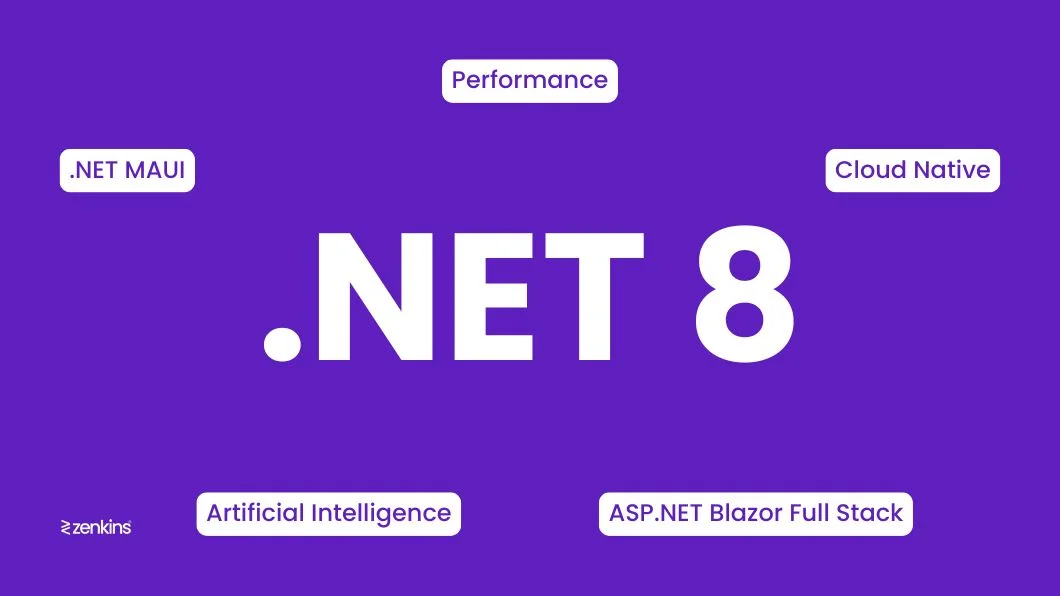.NET 8 – What’s New?
Table of Contents
Introduction
.NET 8 is the latest major release in the .NET ecosystem, bringing a host of new features, enhancements, and optimizations that cater to both new and seasoned developers. As an evolution of Microsoft’s unified .NET platform, .NET 8 continues to build on the promise of making software development faster, more efficient, and highly productive.
Staying updated with the latest .NET versions is crucial for developers and organizations alike. It ensures that applications remain secure, performant, and in line with modern standards. With .NET 8, Microsoft continues to focus on performance, cloud-native capabilities, and enhanced developer experiences, making it a pivotal release in the .NET journey.
Enhanced Performance and Scalability
One of the key areas of focus for .NET 8 is performance. Microsoft has introduced several optimizations in the runtime to ensure applications run faster and consume fewer resources.
1. Runtime Performance Improvements: The .NET 8 runtime has been fine-tuned to provide faster execution times for common operations. This includes optimizations in the Just-In-Time (JIT) compiler, which now produces more efficient machine code. The result is that applications can start faster and perform better under load, making .NET 8 an ideal choice for high-performance applications.
2. Memory Management Updates: In .NET 8, there are significant improvements in memory management, particularly in garbage collection (GC). The GC has been enhanced to reduce pause times and improve throughput, which is particularly beneficial for large-scale, high-throughput applications. This makes .NET 8 more suitable for scenarios where low latency is critical, such as real-time processing systems.
3. Native AOT (Ahead-of-Time) Compilation Advancements: Native AOT has been a much-anticipated feature in the .NET community. .NET 8 expands on Native AOT capabilities, enabling developers to compile their applications directly to native code, bypassing the need for a JIT compiler at runtime. This not only reduces startup times but also results in smaller application sizes, which is especially beneficial for cloud-native and microservices-based applications.
Cloud-Native Enhancements
Cloud-native development has become a cornerstone of modern application architectures, and .NET 8 is designed to excel in this space.
1. Built-in Support for Microservices: .NET 8 introduces new libraries and tools that simplify the development of microservices. These include streamlined APIs for service discovery, configuration, and inter-service communication, making it easier for developers to build robust, scalable microservices architectures.
2. Enhanced Integrations with Kubernetes and Cloud Providers: With .NET 8, deploying .NET applications to Kubernetes and other cloud platforms is more seamless than ever. The .NET team has introduced new integrations that facilitate better orchestration, monitoring, and scaling of .NET applications in cloud environments. This includes improved support for Kubernetes-native diagnostics and observability, which are critical for maintaining high availability and performance in cloud deployments.
3. Cloud Diagnostics and Logging Improvements: Logging and diagnostics are vital components of cloud-native applications, and .NET 8 brings new capabilities in this area. Developers now have access to enhanced logging frameworks that integrate deeply with cloud providers like Azure, AWS, and Google Cloud, providing a more cohesive experience when troubleshooting or monitoring cloud-based .NET applications.
Advancements in Blazor
Blazor has been a standout feature in the .NET ecosystem, allowing developers to build interactive web applications using C# instead of JavaScript. .NET 8 takes Blazor to the next level with several key updates.
1. Blazor United: Combining Server-Side and Client-Side Blazor: One of the most exciting developments in .NET 8 is Blazor United, a new approach that blends the strengths of server-side and client-side Blazor. This hybrid model allows developers to build applications that can dynamically switch between server-side rendering (SSR) and client-side rendering (CSR) based on the context, resulting in better performance and a smoother user experience.
2. Improved Performance and Interactivity: Blazor in .NET 8 comes with a host of performance improvements, including faster rendering, reduced latency, and better handling of large datasets. These enhancements make Blazor applications more responsive and capable of handling complex, interactive web interfaces.
3. New Blazor Components and Features: .NET 8 introduces new components to the Blazor library, expanding the toolkit available to developers. These include improved support for input components, enhanced binding capabilities, and new options for state management. These updates make Blazor a more versatile choice for building modern web applications.
Unified Development with .NET MAUI
.NET MAUI (Multi-platform App UI) is a cross-platform framework that allows developers to create applications for Android, iOS, macOS, and Windows from a single codebase. With .NET 8, MAUI sees several enhancements that make cross-platform development even more streamlined.
1. Simplifying Cross-Platform Development: .NET 8 introduces a unified project system for .NET MAUI, which simplifies the setup and management of cross-platform applications. This new system reduces the complexity of targeting multiple platforms, allowing developers to focus more on writing code and less on configuration.
2. New Features in .NET MAUI: .NET 8 brings a host of new features to MAUI, including better performance on mobile devices, new controls for building more intuitive user interfaces, and enhanced support for platform-specific APIs. This makes .NET MAUI a compelling choice for developers looking to build applications that run natively on multiple platforms with minimal effort.
3. Case Studies of Apps Built with .NET MAUI: Developers have already started to leverage the power of .NET MAUI in .NET 8 to build diverse applications. From enterprise-level solutions to consumer apps, .NET MAUI is proving to be a versatile framework that caters to a wide range of use cases. Highlighting a few case studies can provide valuable insights into how .NET MAUI is being utilized in the real world.
C# 12 Updates
The evolution of C# continues with version 12, which introduces several new features aimed at making development more intuitive and expressive.
1. Key New Features in C# 12: Some of the standout features in C# 12 include Primary Constructors for non-record classes, allowing for more concise object initialization, and interpolated string handlers, which provide more control over string formatting and performance. These features help developers write cleaner, more maintainable code.
2. How These Updates Impact .NET 8 Development: The new features in C# 12 are designed to enhance the overall .NET 8 development experience. For example, the improved pattern matching capabilities in C# 12 allow for more expressive and readable code, which is particularly useful in large applications where clarity and maintainability are paramount.
3. Examples of C# 12 in Action: Providing concrete examples of how these new C# 12 features can be applied in .NET 8 will help developers understand their practical applications. This could include code snippets demonstrating the use of Primary Constructors, pattern matching, and other new features.
Developer Productivity Improvements
.NET 8 is not just about new features and performance; it’s also about making developers’ lives easier.
1. New Tools in Visual Studio for .NET 8: Visual Studio has always been a powerful IDE for .NET development, and with .NET 8, it gets even better. New productivity tools include enhanced code refactoring options, more intelligent code suggestions, and improved integration with .NET-specific features like Blazor and MAUI.
2. Enhancements in Debugging and Testing: Debugging is a critical part of development, and .NET 8 brings several improvements in this area. These include better support for hot reload, more detailed stack traces, and enhanced support for debugging asynchronous code. On the testing front, .NET 8 includes new testing frameworks and improved integration with popular tools like xUnit and NUnit, making it easier to write and maintain tests.
3. AI-Driven Development Tools and Features: AI is becoming an integral part of modern development, and .NET 8 leverages this trend with AI-driven tools that can assist with code completion, error detection, and performance optimization. These tools not only speed up development but also help developers avoid common pitfalls and write more efficient code.
Security and Compliance
Security is a top priority in .NET 8, with several new features aimed at helping developers build secure, compliant applications.
1. Security Updates in .NET 8: .NET 8 includes new security features designed to protect applications from modern threats. These include improvements in authentication and authorization mechanisms, better encryption options, and enhanced support for securing microservices architectures.
2. Compliance Enhancements for Modern Applications: Compliance with industry standards and regulations is a growing concern for many organizations. .NET 8 introduces new features that help developers build applications that meet compliance requirements more easily, including improved logging, auditing, and data protection capabilities.
3. Best Practices for Secure .NET 8 Applications: Alongside the new security features, Microsoft provides guidelines and best practices for building secure .NET 8 applications. This includes recommendations for securing APIs, protecting sensitive data, and implementing robust authentication and authorization controls.
The Rise of Minimal APIs
Minimal APIs have been gaining traction as a lightweight approach to building APIs in .NET, and .NET 8 further enhances this paradigm.
1. Advantages of Minimal APIs in .NET 8: Minimal APIs offer a simplified approach to building small, high-performance APIs with minimal overhead. They are particularly well-suited for microservices architectures, where reducing complexity and improving startup times are critical.
2. Use Cases and Examples: Minimal APIs are ideal for scenarios where a full-fledged MVC framework would be overkill. Examples include simple CRUD operations, health checks, and other lightweight tasks. Providing sample code and real-world use cases can help developers understand where Minimal APIs can fit into their own projects.
3. Comparing Minimal APIs with Traditional APIs: A comparison of Minimal APIs with traditional ASP.NET Core APIs can help developers decide which approach is best for their needs. This section could explore differences in setup, performance, and scalability, providing guidance on when to use each approach.
Migration and Compatibility
As with any major update, migrating to .NET 8 comes with its own set of challenges and considerations.
1. How to Upgrade to .NET 8: A step-by-step guide on how to upgrade existing applications to .NET 8, including tips on how to handle deprecated features and breaking changes. This can help developers transition smoothly to the new version without major disruptions.
2. Compatibility Considerations: Not all applications will be compatible with .NET 8 out of the box. This section could cover common compatibility issues and how to resolve them, ensuring that developers are prepared for any challenges that may arise during the migration process.
3. Tools to Aid in Migration: Microsoft provides several tools to help with the migration to .NET 8, including the .NET Upgrade Assistant and compatibility analyzers. Highlighting these tools and providing examples of how to use them can make the migration process easier and more manageable.
Community and Ecosystem
The .NET community plays a crucial role in the development and growth of the platform, and .NET 8 is no exception.
1. Contributions from the .NET Community: The .NET community is highly active and contributes significantly to the development of new features, bug fixes, and documentation. This section could highlight some of the key contributions from the community in .NET 8, showcasing the collaborative nature of the platform.
2. Open-Source Projects and Libraries Supporting .NET 8: There are numerous open-source projects and libraries that support .NET 8, providing additional functionality and extending the platform’s capabilities. Highlighting some of these projects can help developers discover new tools and resources that can aid in their .NET 8 development.
3. How to Get Involved: Encouraging developers to get involved in the .NET community can help foster a sense of belonging and contribute to the platform’s continued growth. This could include information on how to contribute to the .NET source code, participate in community discussions, or join open-source projects.
FAQs: .NET 8
What are the main performance improvements in .NET 8?
.NET 8 includes several performance enhancements, such as optimized runtime performance, improved garbage collection for reduced pause times, and advancements in Native AOT (Ahead-of-Time) compilation. These changes result in faster application startup times, better memory management, and improved overall performance.
What is Blazor United, and how does it benefit developers?
Blazor United is a new feature in .NET 8 that combines the best of server-side and client-side Blazor, allowing developers to build web applications that can dynamically switch between server-side rendering and client-side rendering. This approach improves performance, reduces latency, and provides a more seamless user experience.
How does .NET 8 enhance cloud-native development?
.NET 8 introduces built-in support for microservices, enhanced integrations with Kubernetes and other cloud providers, and improved cloud diagnostics and logging capabilities. These enhancements make it easier to build, deploy, and manage cloud-native applications, especially in complex, distributed environments.
What are the new features in C# 12, and how do they impact .NET 8 development?
C# 12 introduces features like Primary Constructors for non-record classes, enhanced pattern matching, and interpolated string handlers. These additions make the language more expressive and concise, which can lead to cleaner, more maintainable code in .NET 8 applications.
What is .NET MAUI, and what’s new in .NET 8?
.NET MAUI (Multi-platform App UI) allows developers to create cross-platform applications for Android, iOS, macOS, and Windows using a single codebase. .NET 8 improves MAUI with a unified project system, better performance on mobile devices, and new controls for more intuitive user interfaces.
How do Minimal APIs in .NET 8 differ from traditional APIs?
Minimal APIs in .NET 8 offer a lightweight and simplified way to build small, high-performance web services with minimal boilerplate code. They are particularly useful for microservices architectures and are easier to set up and deploy compared to traditional ASP.NET Core APIs.
What are the key security updates in .NET 8?
.NET 8 includes improved authentication and authorization mechanisms, better encryption options, and enhanced support for securing microservices architectures. These updates help developers build more secure applications that comply with modern security standards.
How can I migrate my existing applications to .NET 8?
Migrating to .NET 8 involves using tools like the .NET Upgrade Assistant and compatibility analyzers to help transition your codebase. Key steps include reviewing compatibility considerations, addressing deprecated features, and testing your application thoroughly in the .NET 8 environment.
How can developers get involved in the .NET 8 community?
Developers can contribute to the .NET 8 community by participating in discussions on GitHub, contributing to open-source projects, attending .NET meetups and conferences, and sharing their experiences through blogs and social media. Engaging with the community is a great way to stay updated and collaborate with other .NET professionals.
What are some practical use cases for the new features in .NET 8?
Practical use cases for .NET 8’s new features include building cloud-native microservices with enhanced diagnostics, developing interactive web applications using Blazor United, creating cross-platform apps with .NET MAUI, and implementing high-performance web services using Minimal APIs. Each of these features addresses specific modern development needs, making .NET 8 a versatile and powerful platform.
Conclusion
.NET 8 is a major step forward in the evolution of the .NET platform, bringing with it a host of new features, performance improvements, and tools designed to make developers more productive. Whether you’re building cloud-native microservices, interactive web applications with Blazor, or cross-platform apps with MAUI, .NET 8 offers something for everyone.
As we look to the future, it’s clear that .NET will continue to evolve and adapt to meet the needs of modern software development. By exploring the new features in .NET 8 and staying engaged with the community, developers can ensure they remain at the forefront of this exciting journey.
Are you ready to dive into .NET 8? Let’s build the future together.




